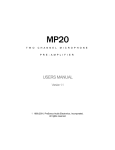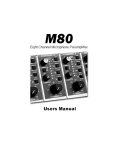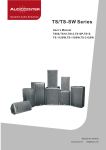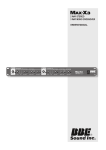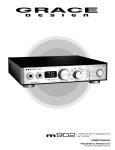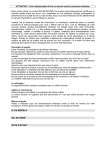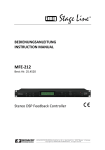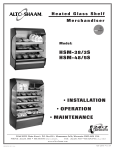Download TL AUDIO M4 TUBE CONSOLE
Transcript
TL AUDIO M4 TUBE CONSOLE USER MANUAL TL AUDIO M4 1 TUBE CONSOLE M4 INTRODUCTION......................................................................................................................................... 3 M4 MIXER TECHNICAL SPECIFICATION. ............................................................................................... 4 Mic Input: ........................................................................................................................................................ 4 Line Input:........................................................................................................................................................ 4 Phase Rev: ....................................................................................................................................................... 4 High Pass Filter: ............................................................................................................................................. 4 Frequency Response: ...................................................................................................................................... 4 Distortion:........................................................................................................................................................ 4 Noise: ............................................................................................................................................................... 4 EQ: ................................................................................................................................................................... 4 Insert Point: ..................................................................................................................................................... 4 Track Output:................................................................................................................................................... 4 Fader: .............................................................................................................................................................. 5 L+R Outputs:................................................................................................................................................... 5 Aux Sends:........................................................................................................................................................ 5 Talkback: ......................................................................................................................................................... 5 Stereo Returns: ................................................................................................................................................ 5 Monitoring:...................................................................................................................................................... 5 Power Supply:.................................................................................................................................................. 5 Digital I/O: ...................................................................................................................................................... 6 Dimensions: ..................................................................................................................................................... 6 M4 MIXER OPERATION.................................................................................................................................. 7 Phase Reverse.................................................................................................................................................. 8 Insertion Points................................................................................................................................................ 9 Aux Sends......................................................................................................................................................... 9 Track Level Control......................................................................................................................................... 9 Pan Control ................................................................................................................................................... 10 Mute Switch ................................................................................................................................................... 10 Aux Masters ................................................................................................................................................... 11 Monitor and Headphone Level ..................................................................................................................... 11 PFL Balance Level ........................................................................................................................................ 11 2 M4 Introduction The M4 is the perfect solution for the modern day studio. Anyone who has used or heard our outboard equipment, will be familiar with its ability to create a warm, smooth, and clean sound that can inject wonderful ‘feel’ into your recordings. Our acclaimed VTC console has also now been accepted as a great sounding must have in the professional recording environment, with many high profile users. The M4 offers you the quality of our outboard, in a desk that is more compact and affordable than the VTC – but still offers you the same great sound. It has been designed to maximise today’s recording techniques, with the addition of an optional ADAT output for easy digital connection to your recording device and software. It makes the perfect front end to any digital recording set up, taking away that ‘clinical, sterile’ sound whilst adding warmth and depth to your recordings – giving you the sound that you have been longing for. Everything about the M4 has been designed to give you maximum pleasure, from the unbelievably great sounding 4 band sweepable EQ section, to the numerous valve stages and digital output options. You can be sure that the desk is not only a fantastic piece of engineering, it is also great eye candy! Available in 16, 24 and 32 channel options the M4 combines that classic valve sound with modern functionality. 3 M4 User Manual M4 MIXER TECHNICAL SPECIFICATION. Mic Input: Balanced XLR socket with switchable 48V phantom power, Gain range +16dB to +60dB with 30dB pad, Frequency response +0, -2dB, 20Hz to 40KHz (at 40dB gain), Input noise (EIN) -127dBu (150 ohm source, 22Hz to 22KHz), Switchable +48V Phantom Power. Line Input: Balanced TRS jack socket, Input impedance 22Kohm, Gain range -20dB to +20dB, Maximum input level +26dBu. Phase Rev: Applies to Mic and Line inputs. High Pass Filter: -3dB @ 90Hz, second order. Applies to Mic and Line inputs. Frequency Response: (Line Input to Track Output) +0, -0.5dB, 10Hz to 40KHz. Distortion: 0.4% typical (see note). Noise: -85dBu, 22Hz to 22KHz, (Line Input to Track Output, Input gain and Track level @ 0dB). EQ: 4 Band, with shelving LF/HF and peaking LM/HM, EQ “On” switch and LED, HF +/-15dB @ 10KHz, HM +/-15dB @ 500Hz to 18KHz, LM +/-15dB @ 50Hz to 2KHz, LF +/-15dB @ 100Hz. Insert Point: Balanced send and return on TRS jacks, Nominal level switchable to +4dBu or -10dBu, Insert “On” switch and LED. Insert “Pre” (EQ) switch. Track Output: Channel direct out, independent of mute switch and fader, Track “Pre EQ” switch, 4 Level trim +/-15dB, Nominal level switchable to +4dBu or -10dBu, Noise -85dBu / -97dBu (+4dBu / -10dBu nominal), Maximum level +22dBu / +12dBu (+4dBu / -10dBu nominal), Balanced output on TRS jack. Fader: +12dBu 100mm “K” Series, Mute and PFL switches and LED’s, Routing to L+R busses via Pan control, “Drive” LED with illumination increasing from +4dBu to indicating valve signal level, “Peak” LED illuminating @ +19dBu, monitoring channel input amplifier and post fader signal. L+R Outputs: Balanced mix busses, Balanced insertion points with +4dBu / -10dBu switch, Separate L and R master faders, Output via balanced XLR connectors, Noise -72dBu, Maximum level +26dBu. Aux Sends: Aux 1 and 2 switchable “Pre” fader, Aux 3 and 4 post fader, Channel send level controls plus master level with PFL switch, Balanced outputs with +4dBu / -10dBu switches. Talkback: XLR socket for mic with level control, Switches with LED’s to route to Aux 1 and Aux 2. Stereo Returns: Two, balanced stereo returns with +4dBu / -10dBu switches, Level and balance controls and PFL switches with LED’s. Monitoring: Balanced outputs on TRS jacks, High quality level control with 29mm knob, PFL relative level trim control with +/-20dB range, Switch with LED to select balanced 2 Track return, LS mute switch with LED, Headphone output with independent level control, Twin illuminated 45mm VU meters with “Peak” LED’s, Front panel accessable 0VU trims. Power Supply: External 2U rack mounting supply, 2 metre cable attached to desk with plug and socket on PSU, PSU switchable for 110-220V 60Hz or 220-240V 50Hz use, Typical power consumption 200VA (16 channel), 250VA (24 channel), 300VA (32 channel). 5 Digital I/O: Optional digital ouput module for L+R outputs, and I/O module Dimensions: for each group of 8 channels. Outputs follow “Track” outputs, inputs normalled to analogue “Line” inputs. Please see separate sheets for digital specifications. All consoles are 815mm (32”) deep, plus at least 100mm (4”) at rear of console for PSU and audio connections, All consoles are 222mm (8.75”) high. Length of 16 channel console 694mm (27.3”), Length of 24 channel console 950mm (37.4”), Length of 32 channel console 1206mm (47.5”). (Dimensions include wood trim). Note: 0dB Distortion measured Line Input to Track Output at +4dBu input and gain over a bandwidth of 20Hz to 20KHz. The distortion is predominately tube generated second harmonic. Increasing the “Drive “ level by applying more input gain progressively increases the distortion. The above figures are representative of typical production consoles, but are not guaranteed limits for any particular console. These specifications are subject to change without notice. 6 M4 MIXER OPERATION Input Selection You must ensure that the correct input connector, mic or line, is being used from the required source. You can select the type of input by pressing the 'LINE' switch at the top right of each channel strip in or out. In the "up' position the mic input is selected; depressing the 'LINE' switch selects the line input as the source. Note that you can have mic and line inputs connected at the same time but will only be able to select a single input at a time. Input Gain Control The gain control should be set to obtain the best signal to noise ratio, whilst preserving adequate headroom. Any changes in gain level should be gradual to avoid sudden overload or severe distortion. Extra care should be taken with higher level inputs, and high gain settings should be used sparingly to avoid an increase in the noise floor and the introduction of distortion. Line Input A typical line input will require less gain than a microphone signal as it is a 'hotter' source. You should have the gain set to a minimum when connecting a line input, then gradually increase it to achieve the required level. Microphone Input When connecting a microphone to the M4, start with the gain set to a minimum value and gradually increase until the sound source is just tickling 0dB on the meters when the source sound is at average output level. You can than choose how much you would like to drive the valves to produce the required sound. If Phantom power is needed, activate it before setting the gain by depressing the button marked '48V' at the back of the channel strip. Although the M4 provides 48V of phantom power, microphones requiring less than 48V can still be connected without any difficulties. CAUTION: Operation of the phantom power switch, or plugging a microphone in with the phantom power applied, may cause an audible click or thump in your loudspeakers. To avoid this happening, ensure that the channel fader and stereo master faders are set to a minimum before operating the switch or plugging in a microphone. Switching between mic and line with high input gain settings may also cause an audible thump if the level control is not turned down. 7 Phase Reverse The phase reverse switch, located to the bottom left of the gain control and labeled 'PHASE', is used to invert the phase of the input signal. It is active on both mic and line inputs. This function could be required when processing a signal that is out of phase with other signals in a mix, in which case the resultant phase error typically appears as a loss of low frequency content, due to cancellation of out of phase components. Phase reverse is commonly used when recording the bottom of a snare drum (if also using a mic on top of the snare), the back of a guitar cab (if also recording signal from the front of the cab), and when performing the stereo recording technique known as an MS pair. High Pass Filter This low cut filter provides 12dB per octave of gain reduction with the -3dB point being at 90Hz. Like the phase reverse switch, the high pass filter is active on both mic and line inputs, and is ideal for removing low frequency rumble. The filter can be useful in restricting 'popping' on vocals or even low frequencies caused by contact with microphone stands or microphone cables. Popping is an undesirable thump that is caused by close-miking certain spoken or sung letters, namely 'P' or 'B'. These particular letters cause a sudden expulsion of air that can result in an audible thump. As this thump has a lot of low frequency content the high pass filter can help to reduce the problem, as can using a pop filter (a device usually made out of nylon material similar to stockings) suspended in front of the microphone. The low cut filter is easily bypassed for quick A/B comparison. 30dB Pad Occasionally when using sensitive condenser microphones the source signal may be too loud for the input preamp. In this situation, to avoid any overloading or distortion of the mic preamp stage, the 30dB pad can be used to reduce the input gain to a more manageable level. The 30dB pad only applies to the microphone input. Equalisation Before switching the EQ into circuit, it is advisable to set the cut/boost controls to their centre, or flat, position. The EQ is brought into circuit with the 'EQ' push switch, signalled by a green LED. Each channel has four bands of equalisation: shelving low frequency (LF) (i.e. it extends from the selected frequency to the extreme low frequency limit of the equaliser's response.), peaking sweepable 8 low-mid (LM) (i.e. it boosts or cuts a section of the audio spectrum around its selected centre frequency only.), peaking, sweepable high-mid (HM) and shelving high frequency (HF). The LF shelf operates at a frequency of 80Hz, while the HF shelf is set at 12kHz. The EQ slopes have a second order 12dB/octave response, and an associated gain control on both bands provides up to 15dB of cut or boost on each selected frequency, controlling the full range of frequencies below the LF corner frequency and above the HF corner frequency. Both mid bands have a fixed Q of 0.7 (which corresponds to a bandwidth of around 1.5 octaves) allowing +/- 15dB cut or boost over a moderately broad band of frequencies. The centre frequency is selected via the dedicated variable frequency control, and the required amount of cut or boost is applied using the associated gain control. The range of frequencies selectable is 50Hz to 2kHz on the LM band, and 500Hz to 18kHz on the HM band, giving a wide spread of frequencies with good overlap in the 500Hz to 2kHz region. You should frequently A/B the sound you are Equalising by pressing and depressing the EQ button, it is astonishing how quickly the ear can adjust to changes. By making frequent comparisons you can make sure you do not stray from the required sound. It is also worth spending some time getting used to the EQ on the M4 - it sounds great and you'll be amazed how versatile and musical it can be. Insertion Points Although the insert points are configured to be pre EQ, you can make them post EQ by depressing the button marked 'POST' in the insert section (under the EQ section on each channel strip). There is also a button to enable and disable the insert within the signal chain, this allows for easy A/B comparison of the signal and is also great for live set ups and recording when you want to quickly disable an insert (i.e. a gate). Aux Sends Each channel strip has 4 auxiliary sends, two of which can be set to pre fade send. Pre fade sends would typically be used for creating headphone cues, whilst post fade sends are used for effects sends (i.e. reverb, etc). Aux 1 and Aux 2 are switchable to pre, Aux 3 and Aux 4 are permanently fixed to post fade. Track Level Control This control sets the level of the signal being sent via the direct outputs, in enables you to create a different mix to tape than what is being heard through the main stereo bus from the channel faders - ideal for live situations. The direct output is also selectable to become Pre EQ by pressing the button located to the bottom right of the track level knob. If you want the level to tape to be the same value as the fader then leave the knob in the central position, set to 0dB. 9 Pan Control The pan control positions the image within the stereo field, from fully left in the anticlockwise position, through centre at the dented position to fully right in the clockwise position. The gain law is -3dB at the centre. Mute Switch The channel may be muted or switched on without affecting the level set on the channel fader. Red LED indicators show which channels are currently muted. PFL Switch When PFL (Pre Fade Listen) is activated a yellow LED illuminates above the button on the channel strip and also in the master section. PFL allows you to monitor the incoming source before it reaches the channel fader and the signal is sent to the main output. It is normal to use PFL when setting the gain level for an incoming source. Channel Fader A 100mm fader is located at the bottom of the channel, and sets the level of the channel's signal being fed to the stereo mix bus. The fader provides up to 10dB of gain at its highest point. Drive and Peak LEDs The yellow Drive LED provides a visual indication of the signal level through the input valve stage, and therefore the extent of 'warming' or valve character being introduced. The drive LED will gradually illuminate as the input level or gain is increased, over the range +6dBu to +16dBu. The red Peak LED operates as a conventional warning that clipping is about to occur. The operating level of both input and post fader stages is monitored, and the LED illuminates at a threshold of +21dBu, when there is less than 5dB of headroom remaining to the direct output. Normal operation would be to set the input gain so that the Drive LED is illuminating regularly, with occasional illumination of the Peak LED occurring on loud transients. Stereo Mix 10 Two 100mm faders control the stereo mix output level. Aux Masters Each aux send features a rotary master level control, which governs the overall level from the aux output. An associated PFL switch allows each aux send to be auditioned in isolation, by placing the aux signal (pre the master level control) on the PFL buss. An operating level switch is provided adjacent to the rear panel connector which selects whether each aux send functions at -10dB or +4dB, allowing easy interfacing with all types of equipment. Effects Returns The two stereo effects returns are each equipped with a rotary fader and a L/R balance control. Both returns are fed directly into the stereo mix. A PFL switch allows each return to be auditioned in isolation. A mono signal can be fed to either of the returns by connecting it to the left hand return input only. This will automatically feed the mono signal equally to both left and right hand sides of the stereo buss simultaneously. An operating level switch is provided adjacent to the rear panel connector which selects whether each aux return functions at -10dB or +4dB, allowing easy interfacing with all types of equipment. The effects returns are typically used to feed the outputs of FX devices back into the stereo mix, adding 'wet' signal to the 'dry' stereo mix. However, the returns can also be used as simple extra line inputs for signals that require no EQ or FX to be added to them via the mixer. Monitor and Headphone Level The M4 provides a stereo monitor output, for connection to a power amplifier and monitor loudspeakers, plus a front panel headphone output. The Monitor level control governs the level of signal fed to both these outputs. The monitor signal normally follows the main stereo output, but will automatically switch over to the PFL buss whenever any PFL button is pressed, this condition being indicated by a yellow LED. Similarly, the monitor signal will follow the 2T return when the 2T return switch is activated in the master section. PFL Balance Level The PFL Balance control allows adjustment of the PFL signal level relative to the main stereo monitor level, as the PFL signal could be considerably louder than the stereo output - depending on the mix and sound source. 11 2-Track Return When recording the stereo mix output onto DAT or CD-R, for example, it is sometimes useful to be able to monitor the output from the mastering machine, in place of the mixer stereo output, as confirmation that the signal is actually being recorded (this is particularly useful when using a four headed DAT machine or a three -headed analogue 2T machine, since the off-tape signal can be monitored). This is achieved by selecting the 2T Return switch near the monitor level control. This facility may also be used for playback after recording. Loudspeaker Mute This switch mutes the rear panel monitor output. This is particularly useful when using headphones, enabling the main monitors to be muted without needing to turn off their amplifiers. This is also useful for temporarily muting the monitors without needing to alter any fader levels, for instance during a telephone call. Metering Two illuminated VU meters on the M4 will normally monitor the main stereo output, but automatically switch to monitor the PFL buss when any PFL switch is engaged. Similarly, when the 2T return is selected as the monitor source (via the relevant select switch - see section 4.22) the meters will automatically switch to monitor the 2T return. The meters are calibrated to indicate 0VU when a signal level of +4dBu is generated at the main outputs. A pair of red Peak LEDs operate on the stereo buss as a conventional warning that clipping is about to occur. The LEDs illuminate at a threshold of +21dBu, when there is less than 5dB of headroom remaining on the main outputs. Normal operation would be to set the stereo buss fader levels so that occasional illumination of the Peak LEDs occurs on loud transients. Digital Output Option The optional DO8 card can be fitted to the back of the M4 and each card provides 8 channels over ADAT lightpipe. This professional protocol makes for easy connection when conducting computer based recording, and makes the M4 the perfect front-end solution for digital recording set ups. There is also the optional DO2 card that fits into the back of the master section of the M4 and provides stereo digital output in SPDIF format (RCA Phono connectors). The DO2 is has a fixed 24 bit word length, but the sample rate is switchable between 44.1, 48, 88.2 and 96 kHz. These are selectable from the back of the digital card. 12 Wordclock Input A rear panel input (on the back of the DO2 & DO8 card) is provided for connecting the M4 to an external master clock source. The wordclock input connector is a BNC-type terminated in 75 ohms. A FINAL WORD We hope you will enjoy your new M4 console, we're confident that once you start using it you'll wonder how you managed without one! For best results, switch your M4 console on 30 minutes before the start of your session to allow the tubes to fully warm up. Enjoy! 13














